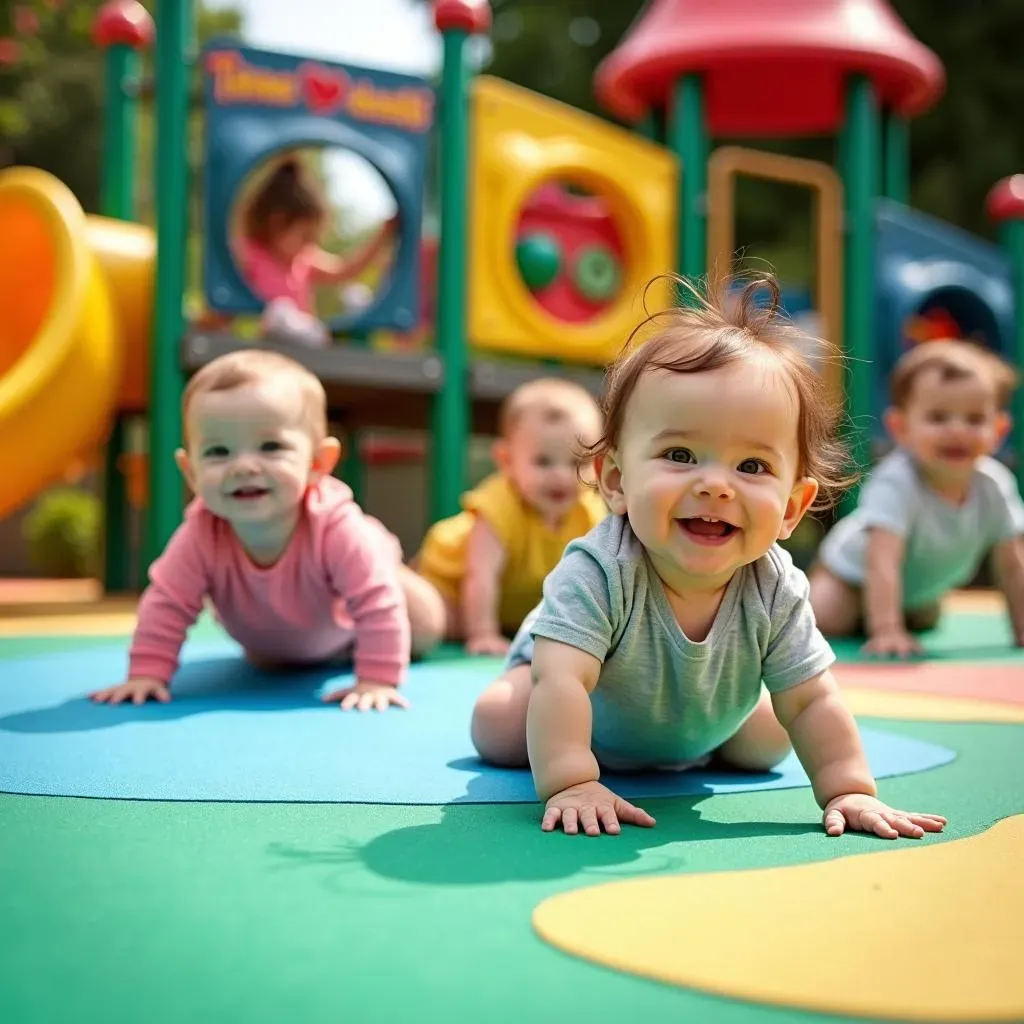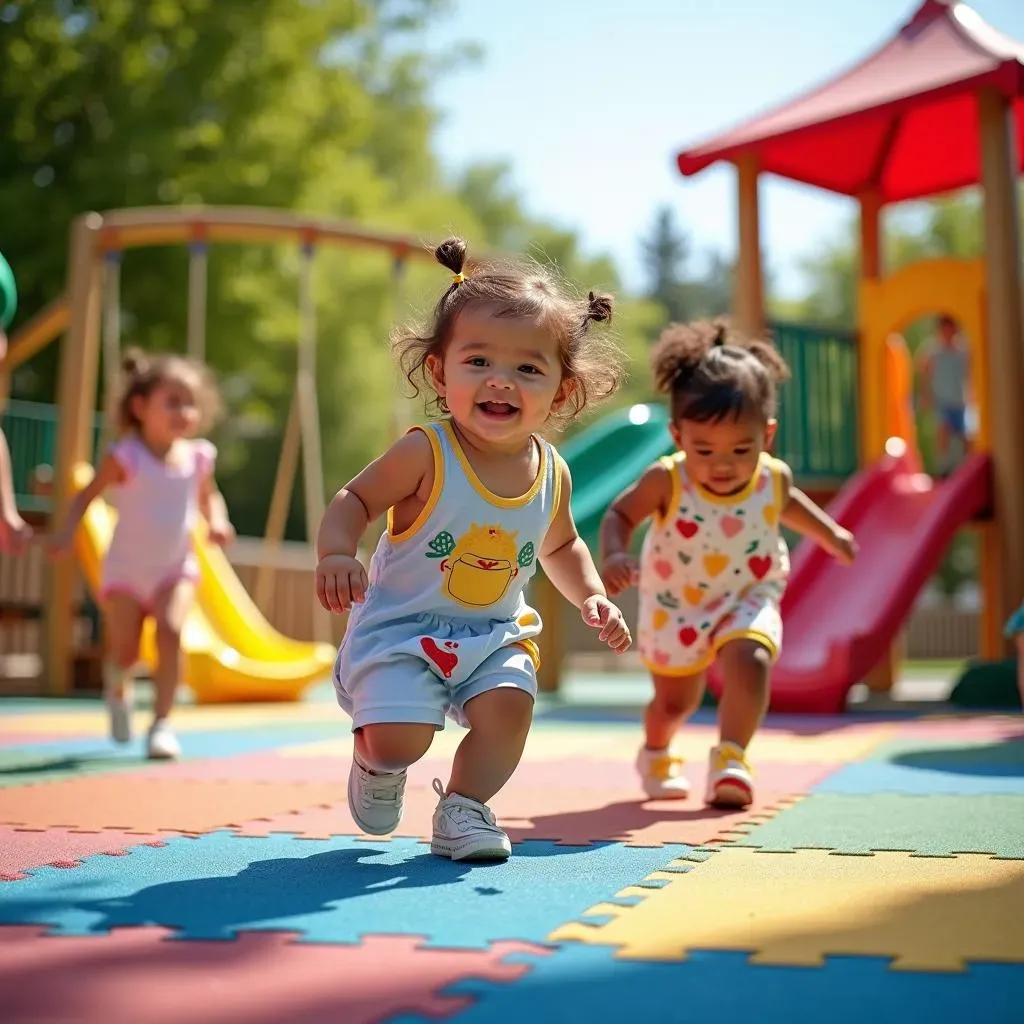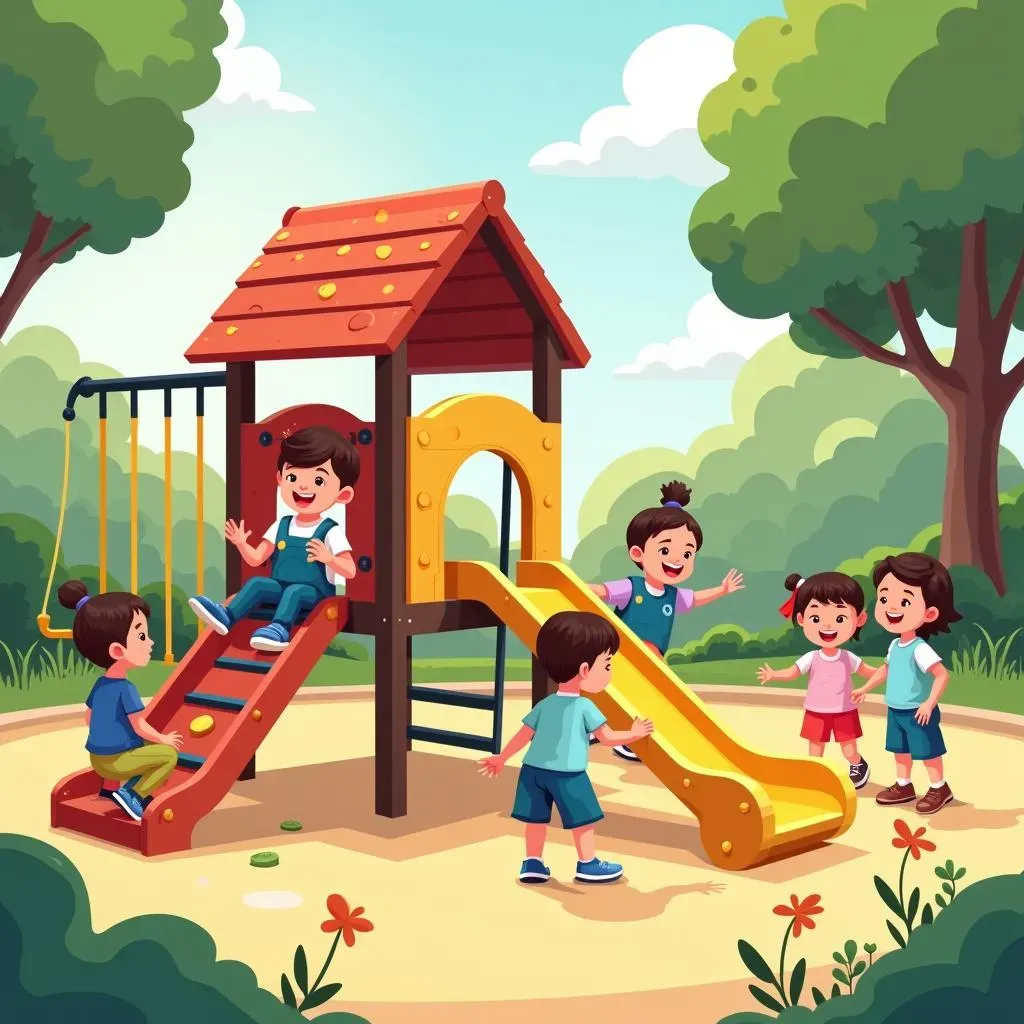Table of Contents
Want to create a fun and stimulating outdoor space for your little ones? Choosing the right infant outdoor playground equipment is crucial for their development and safety. Playgrounds aren't just about fun; they're essential for building motor skills, sparking creativity, and fostering social interaction from a young age. This article will guide you through selecting the best equipment for infants (6-23 months) and toddlers (2-5 years), highlighting key features, safety standards, and funding options to bring your playground dreams to life. We'll explore age-appropriate equipment, from sensory-rich activity panels for infants to adventurous climbers for toddlers. Safety is paramount, so we'll delve into essential safety features and materials. Thinking about budget? We'll also cover practical advice on funding and saving on your playground project. So, let's dive in and discover how to create an engaging and safe outdoor play haven for your little explorers!
Choosing Safe & Developmentally Appropriate Infant Playground Equipment (623 Months)

Choosing Safe & Developmentally Appropriate Infant Playground Equipment (623 Months)
Prioritizing Safety: Materials and Design
When it comes to infant playground equipment, safety is non-negotiable. We're talking about babies and toddlers, so everything needs to be extra secure and designed with their limited mobility in mind. Look for equipment made from high-quality, durable, and non-toxic materials. Think PVC-free plastics and smooth, splinter-free wood. Rounded edges are a must to prevent bumps and scrapes, and any climbing structures should have soft, impact-absorbing surfaces underneath.
The design should also be age-appropriate. Avoid anything too high or challenging that could lead to falls. Instead, focus on low-to-the-ground structures with secure handholds and supports. Regular inspections are also crucial to maintain a safe play environment. It's like baby-proofing your house, but on a larger scale!
Developmental Benefits: Stimulating Sensory Exploration
Infant outdoor playground equipment isn’t just about safety; it's a fantastic opportunity to stimulate their developing senses. At this age, babies are exploring the world through touch, sight, and sound. Choose equipment that incorporates a variety of textures, colors, and sounds to engage their curiosity. Think activity panels with different surfaces to touch, bright and contrasting colors to catch their eye, and gentle sounds like rattles or chimes to stimulate their auditory senses.
Mirrors are also a great addition, allowing infants to discover their own reflections and develop self-awareness. Ball tracks and manipulative toys can help improve hand-eye coordination and fine motor skills. Remember, every piece of equipment should be designed to encourage exploration and learning in a safe and controlled environment.
Developmental Area | Example Equipment | Benefit |
|---|---|---|
Sensory | Textured Panels, Musical Toys | Stimulates touch, sight, and sound |
Motor Skills | Ball Tracks, Crawling Tunnels | Improves hand-eye coordination and gross motor skills |
Cognitive | Mirrors, Shape Sorters | Encourages self-awareness and problem-solving |
Essential Features: Crawling Spaces, Activity Panels, and More
What specific features should you look for when selecting infant outdoor playground equipment? Crawling spaces are perfect for encouraging mobility and exploration, while activity panels with manipulative toys can keep little hands busy and engaged. Look for equipment with sturdy walls and handholds to help infants transition from crawling to walking.
Soft, padded surfaces are essential for protecting those wobbly knees and heads. Consider adding a small, age-appropriate slide or ramp to introduce a sense of adventure. Just make sure it's low to the ground and has a gentle slope. And don't forget about shade! Protecting infants from the sun is crucial, so choose equipment with built-in shade structures or consider adding a separate shade sail.
- Crawling Tunnels: Encourage gross motor skills and exploration.
- Activity Panels: Stimulate fine motor skills and sensory development.
- Soft Padded Surfaces: Protect against bumps and falls.
- Shade Structures: Provide protection from the sun.
Toddler Outdoor Playground Equipment: Fostering Growth Through Play (25 Years)

Toddler Outdoor Playground Equipment: Fostering Growth Through Play (25 Years)
Alright, now let's talk about toddler outdoor playground equipment! This is where things get really exciting. Toddlers are bursting with energy and curiosity, and their play equipment should reflect that. We're talking about kids aged 2 to 5, so they're ready for more challenging and adventurous play structures. Think about it: they're refining their motor skills, developing their balance, and starting to engage in more complex social interactions. The playground becomes their stage for all of this!
The key here is to provide a variety of equipment that caters to different aspects of their development. You want structures that encourage physical activity, like climbing frames and slides, but also areas that stimulate their imagination and social skills, like playhouses and themed play areas. It's all about creating a well-rounded play environment that keeps them engaged and learning.
Unleashing Energy: Slides, Climbers, and More
When you're choosing toddler outdoor playground equipment, think about structures that allow them to test their physical limits in a safe way. Slides are a classic for a reason – they provide a thrilling sense of speed and help develop balance and coordination. Climbers, whether they're small rock walls or rope ladders, challenge their strength and problem-solving skills. Just make sure everything is appropriately sized and has safety features like guardrails and soft landing zones.
Don't underestimate the power of simple swings! Swinging helps develop gross motor skills, coordination, and even spatial awareness. Plus, it's just plain fun! Consider adding a small balance beam or stepping stones to further challenge their balance and coordination. Remember, the goal is to provide opportunities for them to push their boundaries and develop their physical abilities in a safe and supportive environment.
Equipment Type | Developmental Benefit | Safety Considerations |
|---|---|---|
Slides | Balance, coordination, spatial awareness | Appropriate height, smooth surface, safe landing zone |
Climbers | Strength, problem-solving, gross motor skills | Secure handholds, soft landing surface, age-appropriate challenge |
Swings | Gross motor skills, coordination, spatial awareness | Secure seats, appropriate spacing, soft ground covering |
Key Features and Safety Standards for Infant and Toddler Outdoor Play Equipment

Key Features and Safety Standards for Infant and Toddler Outdoor Play Equipment
Material Matters: Prioritizing Non-Toxic and Durable Options
When we're talking about key features and safety standards for infant and toddler outdoor play equipment, the materials used are absolutely critical. You want to ensure that everything is non-toxic, durable, and able to withstand the elements. Think about it: kids are going to be putting their mouths on things, climbing all over everything, and the equipment is going to be exposed to sun, rain, and maybe even snow! So, you need materials that can handle all of that without breaking down or leaching harmful chemicals.
Look for things like PVC-free plastics, which are much safer than traditional PVC. Opt for sustainably sourced wood that's been treated with non-toxic preservatives. And make sure any metal components are rust-proof and free of sharp edges. It's worth investing in high-quality materials upfront because it will save you money and headaches in the long run, and most importantly, it will keep the little ones safe.
Also be careful with loose fill surfacing like wood chips or sand. If you do decide to use these, make sure they are regularly maintained and meet the recommended depth for fall height protection.
Design Details: Minimizing Hazards and Maximizing Fun
The design of infant and toddler outdoor play equipment is just as important as the materials. You want to create a space that's both fun and engaging, but also minimizes potential hazards. That means paying attention to details like rounded edges, secure fasteners, and appropriate spacing between components. Avoid any sharp corners or protrusions that could cause injuries. Make sure any climbing structures are low to the ground and have soft landing surfaces underneath.
Consider the age range of the children who will be using the equipment. What's appropriate for a 6-month-old is very different from what's appropriate for a 4-year-old. Choose equipment that's specifically designed for the developmental stage of the children who will be using it. And don't forget about accessibility! Make sure children of all abilities can access and enjoy the playground.
Safety Feature | Description | Benefit |
|---|---|---|
Rounded Edges | Smooth, curved edges on all surfaces | Reduces the risk of cuts and scrapes |
Secure Fasteners | Bolts, screws, and connectors that are tightly secured | Prevents equipment from falling apart |
Appropriate Spacing | Gaps between components that are not too wide or too narrow | Prevents entrapment hazards |
Soft Landing Surfaces | Padded or resilient surfaces under climbing structures | Reduces the risk of injury from falls |
Regular Inspections and Maintenance: Ensuring Long-Term Safety
Even the safest infant and toddler outdoor play equipment requires regular inspections and maintenance to ensure long-term safety. It's not enough to just install the equipment and forget about it. You need to have a system in place for regularly checking for wear and tear, loose fasteners, and any other potential hazards. This should include daily visual checks and more thorough inspections on a monthly or quarterly basis.
Make sure you have a qualified professional inspect the equipment at least once a year. They can identify potential problems that you might miss and recommend necessary repairs or replacements. Keep detailed records of all inspections and maintenance activities. This will help you track the condition of the equipment over time and identify any recurring issues. And be sure to address any problems promptly! Don't wait until something breaks or someone gets hurt to take action.
- Daily Visual Checks: Look for obvious hazards like broken parts or loose fasteners.
- Monthly Inspections: Conduct a more thorough inspection, checking for wear and tear.
- Annual Professional Inspections: Have a qualified professional inspect the equipment.
- Detailed Record Keeping: Track all inspections and maintenance activities.
Funding Your Dream: Options for Purchasing Infant Outdoor Playground Equipment

Funding Your Dream: Options for Purchasing Infant Outdoor Playground Equipment
Navigating the Budget: Grants and Fundraising
so you're dreaming of a fantastic infant outdoor playground equipment setup, but the budget's looking a little scary? Don't worry, you're not alone! Many organizations face this hurdle, but there are definitely ways to make it happen. One of the best places to start is by exploring grant opportunities. There are tons of grants out there specifically for early childhood development and playground projects. Do some digging online – websites like Grants.gov and foundation directories are great resources. Focus your search on grants that align with your organization's mission and the specific needs of your playground project.
And don't underestimate the power of good old-fashioned fundraising! Get creative with your community. Host a bake sale, organize a fun run, or even launch a crowdfunding campaign. Every little bit helps, and it's a great way to get parents and community members involved in the project. Plus, when people feel invested, they're more likely to support the playground in the long run.
Smart Spending: Phasing Payments and Leasing Programs
Another great way to make purchasing infant outdoor playground equipment more manageable is to explore flexible payment options. Talk to your playground equipment supplier about phasing your payments. This allows you to break up the total cost into smaller, more manageable installments over time. Some suppliers may also offer leasing programs, which can be a great option if you're on a tight budget. Leasing allows you to use the equipment for a set period of time, and then you have the option to purchase it at the end of the lease or return it.
Don't be afraid to shop around and compare prices from different suppliers. You might be surprised at the range of options available. And remember, the cheapest option isn't always the best. Focus on finding equipment that's high-quality, safe, and meets the specific needs of your children. It's an investment in their future, after all!
Funding Option | Description | Pros | Cons |
|---|---|---|---|
Grants | Applying for funding from foundations and government agencies | Large sums of money, no repayment required | Competitive, time-consuming application process |
Fundraising | Organizing events and campaigns to raise money | Engages the community, builds awareness | Can be labor-intensive, may not raise enough money |
Phased Payments | Splitting the total cost into smaller installments | More manageable payments, easier to budget | May incur interest charges |
Leasing Programs | Renting the equipment for a set period of time | Lower upfront costs, flexibility | May be more expensive in the long run, no ownership |
Creating Lasting Memories with Quality Infant Outdoor Playground Equipment
Investing in high-quality infant outdoor playground equipment is an investment in your child's future. Play is fundamental to early development, fostering physical, cognitive, and social skills that lay the groundwork for a lifetime of learning and growth. By prioritizing safety, choosing age-appropriate equipment, and exploring available funding options, you can create a vibrant and engaging outdoor play space where children can thrive. Don't hesitate to reach out to experts for guidance and quotes to ensure you're making the best choices for your little ones. Let's build playgrounds where imaginations soar and memories are made!